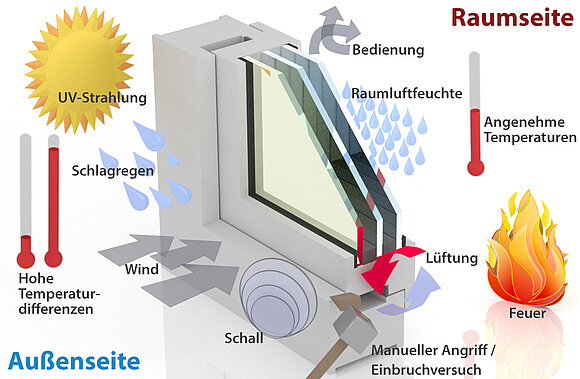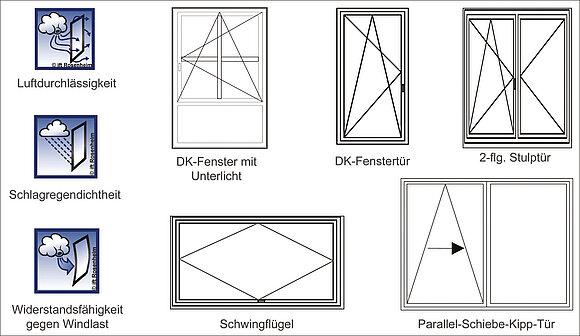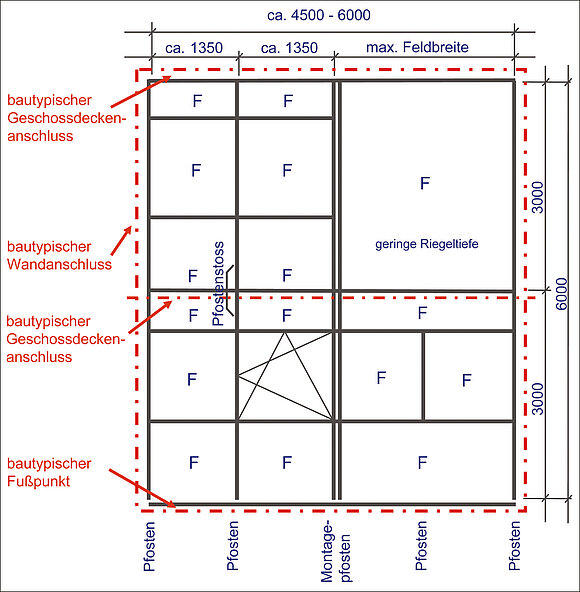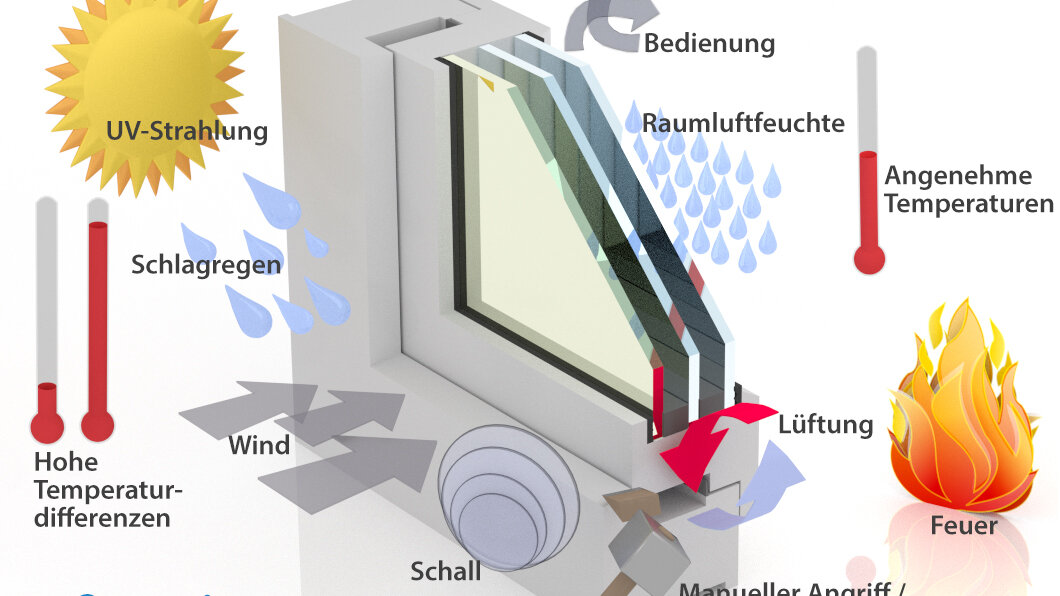Reading time: 1 minute
The development cycles of windows and facades are becoming increasingly shorter. As a result, the risk of weak spots or faults creeping in during construction is becoming increasingly greater.
This is also being reflected clearly in practical testing at ift: Similar faults and weak spots are being identified repeatedly. Hence, the tests conducted on windows and facades should not only serve as certification that the requirements of the construction are met but, rather, they should be used along with the development process to unearth potential shortcomings or defects.
Usability of windows, external doors and facades
Influences on windows, exterior doors and facades may occur both from the room side – for example, by the room air moisture, temperature and use – and also from the outside by rain, wind, change in temperature and humidity, solar radiation and noise, but also by mechanical attack during burglary or by aggressive environmental influences. Moreover, forces caused by movements in construction works, and from the construction product itself, act on it by change in length or shape or by the self-weight of the construction product.

Experience from testing
Selection of test specimens
The test specimen should be representative for the respective product family or the product. Several test specimens / product families may be necessary to cover one system.
The "worst case" method is used for determining the parameters in order to achieve good transferability to other designs. The most diverse designs are integrated into the test specimen(s) to cover any variants. This applies to both windows and facades. This is why a high level of attention must be paid at the time of the selection of test specimens in order to cover the "system" as well as possible.
Impermeability and wind resistance
One of the elementary requirements of windows, exterior doors and facades is watertightness (impermeability against driving rain) and wind resistance. In the process, the building height, the location of the building and the surrounding development play a crucial role.
The construction products must be dimensioned in such a manner that the wind load does not lead to any functional impairment or residual deformations. Wind load assumptions are made for this purpose that take the flow-related characteristics of the building (pressure and suction) into account. The computation tool "ift recommendations for use" offers support for selecting the required class for windows and exterior doors.
Curtain walls
The shortcomings in workmanship mentioned below lead to failure or poor classification in practical tests:
- Inadequate care and diligence in the design of the inner sealing level,
- Absence of or improper drainage of the second drainage level,
- Absence of or insufficiently dimensioned drainage openings in element facades,
- Non-compliance with the fabrication and installation instructions,
- Inadequate sealing of penetrations,
- Absence of pressure equalisation,
- Too low or non-uniform contact pressure of the contact pressure rails,
- Incorrect dimensioning of the profiles.
Windows and exterior doors
The following weak spots occur often:
- Inadequate sealing of the frame joints such as, e.g. corners of mitres, T-joints,
- Insufficient or missing sealing and bonding of seals in corners, especially in middle seals and those used for glazing,
- Mitres not plastered carefully or cutting not done, especially in co-extruded and heat-sealed gaskets,
- Wooden windows: Missing or inadequate sealing of the end caps of weather protection rails, lack of even transition between the rebate and the weather protection rails, corner formed by the sash or frame seal not even,
- Exterior doors: Sealed joint of the sill to the frame member not sealed or only insufficiently sealed – this also involves the risk of water penetration into the building structure and destruction of the wooden frame,
- Absence of or too little pressure equalisation.
Long term performance
The problems occurring occasionally with the endurance test are:
Windows and French doors:
- Hardware breakage or deformation (locking cams, bending of claws, corner bearings, etc.),
- Excessive wear and tear of hardware parts,
- Wear and tear of seals.
- Screw connections coming loose.
Outside doors:
- Lock mechanism breaking or getting damaged,
- Damage to the locking plate,
- Wear on the hinge / breakage of the hinge attachment,
- Wear and tear of seals.

Sound insulation
Apart from determining the acoustic parameters, measurement in the laboratory or at the construction site is often used to analyse the weak spots. Examples of recurrent weak spots are:
- Inadequate or absence of contact pressure in the hardware, thus leading to seals becoming ineffective,
- Sashes are manufactured too small in size, and thus, there is inadequate sealing surface,
- Use of seals or gaskets with very low deflection or missing seals, e.g. in middle seal windows, absence of the exterior rebate seal,
- "Improper" transfer of measurements results to windows with other profile view widths,
- Use of improper glazing, e.g. use of glazing with PVB film instead of acoustic film in the composite pane.
Burglar resistance
Even while testing burglar resistance, often recurrent weak sports are identified:
Facades:
- Very low stiffness of the pressure plate,
- Absence of or inadequate locking of the pressure plate screw connection,
- Absence of or inadequate spacer blocking of infill panels,
- Insufficient glass penetration into the frame,
- Too large distance between screw connections,
- Inadequate fastening of integrated and openable elements.
Windows and doors:
- Inadequate fixing of the hardware,
- Hardware not accurately adjusted and not installed diligently, consideration of the "loss in lift" or the rebate air,
- Wooden components: Improper selection of the type of wood with respect to raw density and fabrication,
- Plastic components: Improperly placed armouring, embrittled plastic
- Steel components: Very low material thicknesses for adequate screw connection
- Glazing: Inadequate or incorrect design for securing of the glazing

Summary
The essential aspects of a working construction are – apart from the detailed and holistic design and planning – diligence and attention during execution, constant monitoring of the properties by tests and by the factory production control. For this purpose, it is absolutely necessary to describe the fabrication and workmanship in detail, in order to provide the fabricators the opportunity of reproducing the test elements in large-scale manufacture. It is only with consistent analyses of the weak spots from the start of the development process that the risk of unnecessary costs of rectifying defects or shortcomings or, in fact, replacement of the products can be mitigated. Tests conducted by skilled personnel in the course of development are absolutely necessary here. This applies not only to the properties illustrated here by way of examples, but rather to all properties that contribute to the durability and suitability of use of the product.
|
